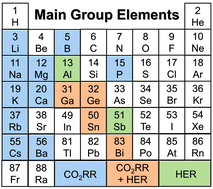Main group elements in electrochemical hydrogen evolution and carbon dioxide reduction
Abstract
Main-group elements are renowned for their versatile reactivities in organometallic chemistry, including CO2 insertion and H2 activation. However, electrocatalysts comprising a main-group element active site have not yet been widely developed for activating CO2 or producing H2. Recently, research has focused on main-group element-based electrocatalysts that are active in redox systems related to fuel-forming reactions. These studies have determined that the catalytic performances of heavier main-group element-based electrocatalysts are often similar to those of transition-metal-based electrocatalysts. Our group has recently reported the scope of including the main-group elements in the design of molecular catalysts and explored their applications in redox catalysis, such as the generation of H2 upon coupling of two protons (H+) and two electrons (e−). This feature article summarizes our research efforts in developing molecular electrocatalysts comprising main-group elements at their active sites. Furthermore, we highlight their influence on the rate-determining step, thereby enhancing the reaction rate and product selectivity for multi-H+/multi-e− transfer catalysis. Particularly, we focus on the performance of our recently reported molecular Sn- or Sb-centered macrocycles for electrocatalytic H2 evolution reaction (HER) and on how their mechanisms resemble those of transition-metal-based electrocatalysts. Moreover, we discuss the CO2 reduction reaction (CO2RR), another promising fuel-forming reaction, and emphasize the recent progress in including the main-group elements in the CO2RR. Although the main-group elements are found at the active sites of the molecular catalysts and are embedded in the electrode materials for studying the HER, molecular catalysts bearing main-group elements are not commonly used for CO2RR. However, the main-group elements assist the CO2RR by acting as co-catalysts. For example, alkali and alkaline earth metal ions (e.g., Li+, Na+, K+, Rb+, Cs+, Mg2+, Ca2+, and Ba2+) are known for their Lewis acidities, which influence the thermodynamic landscape of the CO2RR and product selectivity. In contrast, the elements in groups 13, 14, and 15 are primarily used as dopants in the preparation of catalytic materials. Overall, this article identifies main-group element-based molecular electrocatalysts and materials for HER and CO2RR.

- This article is part of the themed collections: 2023 Emerging Investigators and Chemical Communications HOT Articles 2023


 Please wait while we load your content...
Please wait while we load your content...
